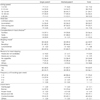Abstract
The objective of this study was to assess dietary habits and nutrition knowledge of elementary school students who use community food-service centers according to family type. The subjects were comprised of 147 individuals in low-income households, aged from 7 to 12 years, and who consumed free meals at community welfare centers or at local children's centers in Seoul and Kyunggi-do, Korea. Dietary habits and dietary intake were obtained using 24-hr recall. Children in low-income single parent families skipped breakfast more frequently than children in low-income married parent families. No difference in nutrition intake or dietary habits was observed between children in low-income single parent families and children in low-income married parent families. More interest and financial support of the government are required to develop nutrition education and food assistance programs for children in low-income single parent families.
Figures and Tables
Table 3
Nutrition knowledge based on family type

Values are percent of subjects who answered correctly. 1) Significantly different between boys and girls in lower grade in low-income single parent households, p < 0.05. 2) Significantly different between boys and girls in lower grade in low-income married parent households, p < 0.05. 3) Significantly different between boys in upper grade in low-income single parent households and boys in upper grade in low-income married parent households, p < 0.05
References
1. Lyu YG, Choe HS. Levels and trends in child poverty in Korea: focused on urban non-farm households, 1982~2002. J Korean Soc Child Welf. 2003. 16:135–165.
2. Single parent family support. Ministry of Gender Equality and Family. 2010. Available from:
http://www.twin.or.kr/bbs/upload/input/Board_data7_2664_1.pdf.
3. Jang HJ. The poor children's status and its investigation. J Korean Living Sci Assoc. 2000. 9(3):257–270.
4. Chung MR, Kwak E, Youn JS. Comparison of parenting between middle and low income families. J Korea Open Assoc Early Child Educ. 2007. 12(4):347–369.
5. Heo GY, Son SK. The study of nutrient intake and mineral contents of hair and urine in Autistic children. Korean J Community Nutr. 1996. 1(3):346–353.
6. Son SM, Yang CS. Nutritional status of 5th grade school children residing in low-income area of Pucheon City. Korean J Community Nutr. 1997. 2(3):267–274.
7. Chung KH. Lunch program for needy children: current status and policy recommendations. Health Welf Policy Forum. 2005. 101(3):5–14.
8. Hwang JB. Extended support on free meal for local community center. Available from:
http://www.hani.co.kr/section-003000000/2005/01/003000000200501141824147.html.
9. Park JI. Nutrition knowledge and dietary habits among elementary school students in Jeollanam-do [thesis]. 2005. Asan: Soon Chun Hyang University.
10. Nam KH, Kim YM, Lee GE, Lee YN, Joung H. Physical development and dietary behaviors of children in low-income families of Seoul area. Korean J Community Nutr. 2006. 11(2):172–179.
11. Park HA, Kang JH, Kim KW, Cho YG, Hur YI, Kim OH. Breakfast Skipping, Related Factors, and Nutrients Intake of 5th Grade Students. Korean J Fam Med. 2011. 32(1):11–20.

12. Sung CJ, Sung MK, Choi MK, Kim MH, Seo YL, Park ES, Baik JJ, Seo JS, Mo SM. Comparison of the food and nutrition ecology of elementary school children by regions. Korean J Community Nutr. 2003. 8(5):642–651.
13. Mahoney CR, Taylor HA, Kanarek RB, Samuel P. Effect of breakfast composition on cognitive processes in elementary school children. Physiol Behav. 2005. 85(5):635–645.

14. López-Sobaler AM, Ortega RM, Quintas ME, Navia B, Requejo AM. Relationship between habitual breakfast and intellectual performance (logical reasoning) in well-nourished schoolchildren of Madrid (Spain). Eur J Clin Nutr. 2003. 57:Suppl 1. S49–S53.

15. Ministry of Health and Welfare. Korea Centers for Disease Control & Prevention. 2008 Korean National Health and Nutritional Examination Survey. Available from:
http://knhanes.cdc.go.kr.
16. Freedman DS, Ogden CL, Flegal KM, Khan LK, Serdula MK, Dietz WH. Childhood overweight and family income. MedGenMed. 2007. 9(2):26.
18. Gropper SS, Smith JL, Groff JL. Advanced Nutrition and Human Metabolism. 2009. 5th ed. Belmont, CA: Wadsworth.
19. Contento IR, Manning AD, Shannon B. Research perspective on school-aged nutrition education. J Nutr Educ. 1992. 24:247–260.
20. Axelson M, Federline T, Brinberg DA. A meta-analysis of food and nutrition-related research. J Nutr Educ. 1985. 17:51–54.

21. Lin W, Yang HC, Hang CM, Pan WH. Nutrition knowledge, attitude, and behavior of Taiwanese elementary school children. Asia Pac J Clin Nutr. 2007. 16:Suppl 2. 534–546.




 PDF
PDF ePub
ePub Citation
Citation Print
Print





 XML Download
XML Download